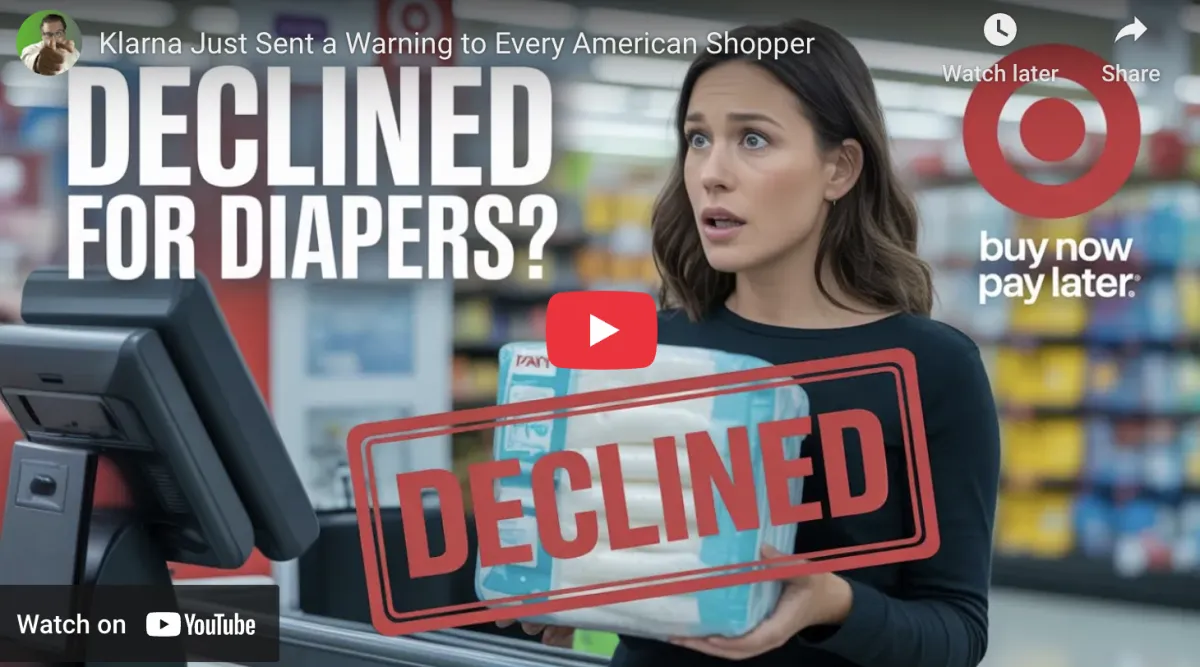
Klarna Just Sent a Warning to Every American Shopper
Living on the Edge: The Debt Crisis Hitting American Households
Imagine being declined for a $37 purchase of baby diapers. That’s not a dramatization—it’s a reality for more Americans than we’d like to admit. With the cost of living soaring and wages struggling to keep pace, millions are resorting to financing basic necessities through Buy Now, Pay Later (BNPL) services and credit cards. But what happens when even those options say no?
We are facing a consumer debt crisis. Credit card debt in the U.S. has surpassed $1.08 trillion, with the average household carrying over $6,000 in balances. But that’s just the middle of the pack—many households are weighed down with $20,000, $30,000, or even $50,000 in revolving credit card debt. With interest rates hovering around 24%, monthly minimum payments are punishing and offer little relief. A $50,000 balance, for example, could cost $14,400 a year in interest alone—while the principal barely budges.
Buy Now, Regret Later: The BNPL Trap
BNPL platforms like Klarna, Affirm, and Afterpay market themselves as no-interest alternatives to credit cards. But they come with a hidden cost—normalizing the practice of living beyond your means. For many, these services are not a convenience but a necessity. And as default rates on BNPL loans double, these companies are tightening their lending standards, leaving vulnerable consumers with nowhere to turn.
Even in affluent neighborhoods, signs of financial distress are visible. Shoppers in high-income areas are seen tallying grocery totals with calculators, trying to avoid overspending. This isn’t just a budgeting strategy—it’s a coping mechanism. Behind the smiles and luxury vehicles are households buckling under the weight of debt, inflation, and financial anxiety.
The Job Market Is Cooling—And That’s a Problem for Borrowers
While employment reports still show strength on the surface, many companies are quietly trimming staff. These “silent layoffs” aren't making headlines, but they’re impacting thousands of workers—many of whom are already financially stretched thin.
Here’s the harsh reality: once you’re unemployed, your financial options shrink dramatically. Banks don’t approve loans or refinance packages for borrowers without income. Your credit profile—no matter how strong it once was—can’t overcome job instability or falling credit scores due to missed or minimum payments.
Why Acting Early Matters More Than Ever
Timing is everything, especially when it comes to managing high-interest debt. The upcoming Federal Reserve meeting on July 30 could lead to a key interest rate cut. While headlines will focus on mortgage rates, the real opportunity lies in using your home equity to consolidate expensive debt.
Let’s do the math. Say you have $40,000 in credit card debt at 24% APR. If you replace that with a home equity line of credit (HELOC) at 7%, you’d save more than $6,000 in annual interest—equivalent to freeing up about $500 a month in cash flow. That’s not just a financial win; it’s a chance to rebuild savings, reduce stress, and start making decisions based on goals instead of desperation.
Don't Wait Until It’s Too Late
The biggest mistake borrowers make? Waiting until they’re in crisis mode. One tech worker, who had been carrying $30,000 in credit card debt for years, recently reached out—right after his company announced layoffs. His credit score had dipped, his income was at risk, and suddenly, lenders were hesitant. Had he acted six months earlier, refinancing would have been simple. Now, it’s an uphill battle against underwriting rules, credit damage, and shrinking loan options.
Final Thoughts: The Window Is Narrow, But It’s Open
The consumer debt crisis isn’t theoretical—it’s unfolding in real time, in every income bracket and neighborhood. And while no one can predict the Fed’s exact timeline or the job market’s next turn, the smart move is to prepare while you still have leverage.
If you’re employed and have equity in your home, now is the time to explore your options. Don’t wait for the banks to tighten lending standards or for your credit score to slip. A short window of opportunity is opening—and it may be your best shot at resetting your financial future before things get worse.
Sources
Forbes – https://www.forbes.com
Investopedia – https://www.investopedia.com
CBS News – https://www.cbsnews.com
Times of India – https://www.timesofindia.indiatimes.com


